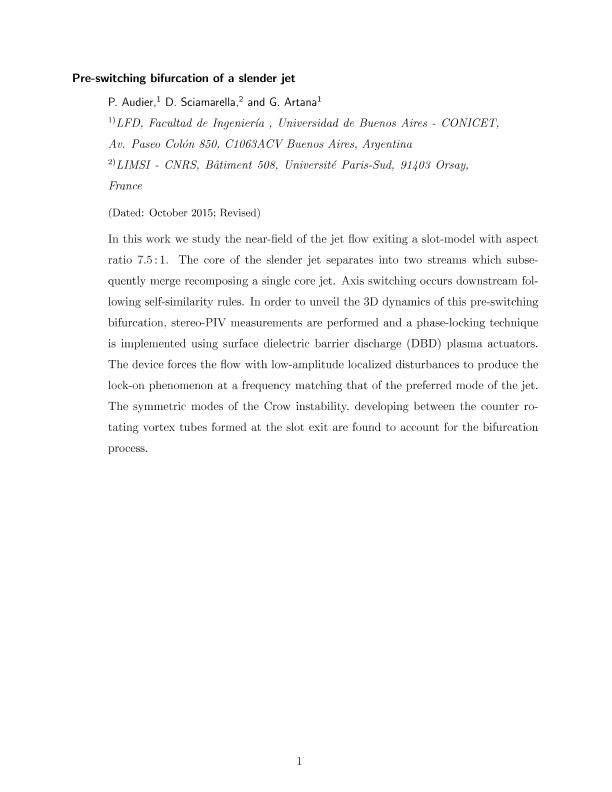Mostrar el registro sencillo del ítem
dc.contributor.author
Gronskis, Alejandro

dc.contributor.author
Artana, Guillermo Osvaldo

dc.date.available
2018-04-27T19:12:40Z
dc.date.issued
2016-01
dc.identifier.citation
Gronskis, Alejandro; Artana, Guillermo Osvaldo; A simple and efficient direct forcing immersed boundary method combined with a high order compact scheme for simulating flows with moving rigid boundaries; Pergamon-Elsevier Science Ltd; Computers & Fluids; 124; 1-2016; 86-104
dc.identifier.issn
0045-7930
dc.identifier.uri
http://hdl.handle.net/11336/43697
dc.description.abstract
A non-boundary conforming formulation for simulating complex flows with moving solid boundaries on fixed Cartesian grids is proposed. The direct forcing immersed boundary method (IBM) is implemented in a direct numerical simulation (DNS) code (called Incompact3d) based on high-order compact schemes for incompressible flows. To satisfy the boundary conditions on the immersed interface, the velocity field at the grid points near the interface is reconstructed via momentum forcing on a Cartesian grid by means of interpolation at forcing points in the fluid domain. A novel interpolation scheme which is applicable to boundaries of arbitrary shape is introduced and compared to a bi-linear model. A variance of this method utilizes a more compact stencil which allows compatibility with two-dimensional domain decomposition of the DNS code. Local force distributions and velocity fields were compared to identify which interpolation scheme best represents the solid boundaries by computing flow induced by a transversely oscillating cylinder. The accuracy and efficiency of the present technique are examined by simulating two-dimensional flow over a traveling wavy foil and comparing against numerical reference data. Finally, we present results from a three-dimensional simulation of a lamprey-like body undulating with prescribed experimental kinematics of anguilliform type, in order to demonstrate the ability of the present implementation in computing flows around moving solid objects with non-trivial geometries.
dc.format
application/pdf
dc.language.iso
eng
dc.publisher
Pergamon-Elsevier Science Ltd

dc.rights
info:eu-repo/semantics/openAccess
dc.rights.uri
https://creativecommons.org/licenses/by-nc-nd/2.5/ar/
dc.subject
Moving Boundaries
dc.subject
Cfd
dc.subject.classification
Ingeniería Mecánica

dc.subject.classification
Ingeniería Mecánica

dc.subject.classification
INGENIERÍAS Y TECNOLOGÍAS

dc.title
A simple and efficient direct forcing immersed boundary method combined with a high order compact scheme for simulating flows with moving rigid boundaries
dc.type
info:eu-repo/semantics/article
dc.type
info:ar-repo/semantics/artículo
dc.type
info:eu-repo/semantics/publishedVersion
dc.date.updated
2018-04-27T13:57:57Z
dc.journal.volume
124
dc.journal.pagination
86-104
dc.journal.pais
Estados Unidos

dc.description.fil
Fil: Gronskis, Alejandro. Universidad de Buenos Aires. Facultad de Ingeniería. Departamento de Ingeniería Mecánica. Laboratorio de Fluidodinámica; Argentina
dc.description.fil
Fil: Artana, Guillermo Osvaldo. Universidad de Buenos Aires. Facultad de Ingeniería. Departamento de Ingeniería Mecánica. Laboratorio de Fluidodinámica; Argentina. Consejo Nacional de Investigaciones Científicas y Técnicas; Argentina
dc.journal.title
Computers & Fluids

dc.relation.alternativeid
info:eu-repo/semantics/altIdentifier/doi/http://dx.doi.org/10.1016/j.compfluid.2015.10.016
dc.relation.alternativeid
info:eu-repo/semantics/altIdentifier/url/https://www.sciencedirect.com/science/article/pii/S0045793015003503
Archivos asociados
